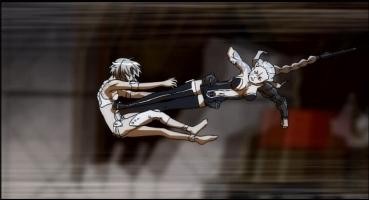|
I
feel I've made all of my most pertinent comments on Burst
Angel's sound and visual effects in my review for Volume
2; if you haven't already, please feel free to read it.
Also take note of my reviews of Volumes 3,
4 and
5.
2003's
animé sensation, Burst Angel, concludes this
month with the release of Volume 6: Guardian Angel. While
in previous volumes, the general "big bad" of the series
had been lurking in the background as the girls went off
on vaguely-related cases and missions, the last four episodes
sees it dragged bodily to the front of the action. And,
as I predicted in my review of Volume 5, most of the hanging
plot points are displayed and tied up in short order.
The
opening episode kicks off the big changes for this volume
– and with it comes the realisation that this final disc
will be devoted entirely to wrapping the series up and won't
follow the episodic pattern established in previous volumes.
In fact, they can't really be called "episodes"; there's
no gap in the narrative and they can be easily watched back-to-back
as a kind of movie. Star Trek: Deep Space Nine's
ten-part series finalé did things in much the same
way.

Those
big changes, by the way, is the total shake-up of the status
quo. Before, we knew where everyone stood: Sei, a member
of the Bai Lan syndicate, was sent to set up a group of
mercenaries in order to study the "glowing brains" phenomenon
(where mysterious cybots were being equipped with advanced
neural technology and sent to run riot in Tokyo). She and
her group – now consisting of stoic Jo, excitable Meg and
computer-whiz Amy – were also tasked with discovering the
true nature of Tokyo's radical new law enforcement brigade,
RAPT.
Now
everything's turned on its head. Bai Lan has merged
with the shadowy organisation behind the glowing brains
and RAPT, meaning that the mercenaries' services
are no longer required. Jo, Meg and Amy (plus resident cook
Kyohei and mechanic Leo) and given their marching orders
by a reluctant Sei, who finds her loyalties brought into
question. She finally realises that she isn't the respected
leader that she thought she was – she's just a minor player
in a huge organisation, and in turn, in a plot to take over
the world!
The
final four episodes – 21-24 of 24 – are as follows:
21:
"Bullets in the Iron Grave Post"
Sei's given the order to disband the mercenary group,
which she does while reminiscing about how she found each
of its members. A creature living in a subway is subdued,
thanks to Jo's last-minute help – but was this all a plot
to lure her into the open?
22:
"Beloved Devil"
The full details of what Jo is and where she comes from
is finally revealed – and the origins of her arch-rival
Maria are very similar. Unsurprisingly, fighting is the
key to knowing everything.
23:
"Execution Ground on the Red Seas"
Maria takes Jo to an isolated submarine in order to
decide who's the best, once and for all.
24:
"Burst, Angels!"
Sei and Jo decide to take on RAPT at its highest levels,
and with Takane returning from Osaka to help them, the stage
is set for the final battle.
The
first thing the volume wraps up is Jo's origin story. The
previous episodes dealing with this plot thread had suggested
a number of explanations: she's an actual angel (as in the
title) from heaven or hell; she's an alien who crash-landed;
she's some sort of supernatural fighting force. But the
answer that I settled upon when I saw episode 14 – which
tells of how Jo met Meg – wasn't entirely derived from the
series. Rather, it was deduced from the most common element
linking many animé series that I've reviewed this
year: morally suspect genetic experiments and cloning technology
that has created a fighting force of enhanced "war machines"
– all of which, of course, happen to be scantily-clad teenage
girls.
While
it wasn't surprising that this was the answer behind Jo's
preternatural strength and ferocity, the way it is used
is completely unlike Gunslinger Girl or She, The
Ultimate Weapon. The issue is never really raised as
abnormal; just a strange experiment made by a scientist
with enough moral bankruptcy not to care that the girls
are living human beings. The scientist in question talks
of the girls' irrepressable human desires and feelings as
a "barrier" that he and his team weren't able to "overcome",
and nobody calls him on it – not even the main characters.
It's just a fact of life, these things happen – and it's
something that I've always been uncomfortable with in stories
like these.

Besides
this, the final volume proceeds at breakneck pace, going
from Jo and Maria's fight to civil uprising and the eventual
high-speed chase with giant robots through the streets of
Tokyo. I'd like to take a moment to further comment on Burst
Angel's stunning CG animation techniques that are used
to render the robots and vehicles – they're incredibly smooth,
very watchable, and don't seem at all out of place. The
best CGI is the type that blends with the traditional animation
so that you don't know it's there, and Burst Angel
consistently accomplishes this.
The
major failing of this last volume is in character closure.
Of the assembled main cast, only Jo, Meg and Sei get any
kind of resolution to their character arcs – Jo and Meg's
relationship, which reaches its apex here, and Sei's questioned
loyalties, culminating in an attack on her own organisation.
Kyohei and Amy are all but written out in the first episode,
and while Leo gets more screen-time, he merely fills his
role of "team mechanic". We know nothing more about him
than we did when we first met him. Takane, of course, was
too good a character not to let back into the action, but
I'm disregarding her here as her story was told back in
the Osakan three-parter spanning volumes 3 and 4.
Burst
Angel has been one of the year's most enjoyable animé
series; both as a throwback to the beginning of the decade,
with its episodic sci-fi tales, and as a reflection on the
state of animé in recent years – which I think I'll
call the "girls with guns" era. As a fanservice piece, it's
not as overt as most, focussing more upon its story and
the plot of each episode while allowing viewers a little
eye-candy. I can recommend Burst Angel to anyone
who enjoys a solid action adventure and isn't put off by
an initial lack of overreaching plot. Watching this series
has been great, and I hope that if you choose to buy it,
you'll find it just as good as I did.
Once
again MVM have done well by Burst Angel
the anamorphic 16:9 transfer boasting good contrast and
colour, with a pleasing level of detail and solid black
levels.
Both
the original Japanese 5.1 and the English 5.1 dubs do a
nice job, with the English track just having the edge in
clarity and spread. The bass is particulkrly well reproduced.
The
series' run of audio commentaries conclude with one for the final episode, "Burst, Angels!".
Voice-director Chris Bevins bringing all four girls' voices
into the stuido with him: Alison Retzloff (Amy), Monica
Rial (Jo), Jamie Marchi (Meg) and Clarine Harp (Sei). Needless
to say, anarchy ensues – the girls giggle their way through
the episode's fanservice points, while a beleaguered Bevins
makes wry observations and attempts to talk about some of
the goings-on behind the scenes.
There's
another Radio Drama, featuring the
Japanese voice cast; these are generally funny, but the
problem is that they're radio productions that often
don't lend themselves to subtitling.
There's
an alternate opening and ending
compiled of clips from the series rather than the original
animation used in the real ones. The Japanese
Trailer for the series is present, as are
other trailers for Saiyuki Reload and
Paranoia Agent.
|